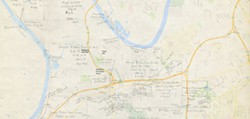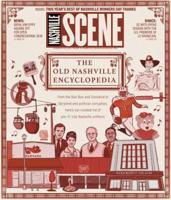
We had peace with the Chickasaw, but everyone else was trying to kill us off. We were at constant war. Still, 1787 was a particularly hard year for the Robertsons.
On March 12, 1787, twelve year old Peyton Robertson, son of James and Charlotte, and similarly-aged neighbor boy Randall Johnson — I can’t prove it, but I’m betting this is a nephew of Ann Robertson-Johnson-Cockrill — were killed on the Robertsons’ land by a really militant faction of Chickamauga aided by some French traders. Charlotte, the story goes, heard the boys screaming and had the presence of mind to open the station door and let the dogs attack the boys’ attackers. (Those of you familiar with the Battle of the Bluffs will remember that a similar legend exists about her behavior during that fight. I can’t tell if there is one instance of Charlotte setting dogs on attacking Indians that has been misremembered over time as having happened two different places or if Charlotte had a pack of dogs she regularly let loose on her enemies. Still, it raises the question: why don't we have a dog park named for this woman?). She was too late. The boys were mortally wounded. They died that day.
That was not the only tragedy to befall the Robertsons. Three short months later, almost to the day, Mark Robertson was killed, as James put it when he wrote to the Governor of North Carolina about it, “near my house.” On the one hand, this seems straightforward. We know this small group of rogue Chickamauga were killing people in the area—they’d killed the boys. If Mark were walking back from James’ house, he would have been ambushed very near to where the boys were killed.
This has been the reason must historians believe — because it’s the reason James Robertson said— that James Robertson took a group of men and went and killed the shit out of the Chickamauga at Cold Water Town.
But Hickman County historians have believed for well over a century that Mark Robertson died in Hickman County. In their A History of Hickman County, W. Jerome D. Spence and David L. Spence explain: “Mark Robertson was, at the time of his death, in the Indian country, and in justification of the Coldwater expedition James Robertson suppressed some of the facts and made the vague statement of ‘near my house.’ […] If the Indians came to Nashville and killed Mark Robertson, James Robertson could have more easily defended his actions in going on the expedition against them than he could if he admitted that, in fact, Mark Robertson was, at the time of this death, surveying in the Indian country and a trespasser on their territory.” (p. 29-30)
I don’t know on what basis the Spences think that Mark was in Indian Country surveying, though, if he was, that’s the kind of thing that could get a white man killed. But I do know that no historians seem to realize that the Robertsons had lost those boys that same spring.
See, here’s the thing. No one knew where Cold Water Town was — they just knew that the warriors there were running up to Nashville and killing people. Mark may have been surveying — though by himself? — but, if I had to lay money on why a white guy was alone in Indian territory — if, indeed, this is where he died — then my guess is that Mark was on a vigilante spy mission, looking for Cold Water Town and the men who had killed those children. And, if that’s the case, we can bet — based on the fact that he didn’t take anyone with him — that he knew he was violating treaties and knew, if he made it back, he’d be in huge trouble with the authorities for his actions and he didn’t want to get anyone in trouble with him. This would also explain James' obfuscation about where Mark died and under what circumstances, if the Hickman historians are right.
Retaliation for the Chickamauga breaking treaties is fine. Retaliation for a killing that was a result of Mark breaking treaties? Way not cool.
While Mark was being murdered, two Chickasaw warriors stumbled across Cold Water Town and reported the location of the town back to Piominko, who then sent the two men to James Robertson to report the location of the village. It’s said that they arrived just as James was learning of Mark’s death.
But the result is the same, no matter where Mark died: James rounded up a group and, in violation of the rules of who got to go off and raze Indian villages, they burned down Cold Water Town, killed both French people and Chickamauga. He had his revenge. Since Cold Water Town was hidden in Creek territory, though, this expedition royally pissed off the Creek.
Still, five years later, in 1792, James Robertson had representatives from all the Indian nations who had dealings with the Nashville settlement over to his house for another sit-down. This and the Battle of Buchanan’s Station laid the groundwork for the cessation of direct hostilities.
Using Google maps and this hand-drawn map of the land grants in the general area of The Nations from the TSLA, I made a composite map that shows generally where the land grants were compared to where things are today. It’s not that great because the hand-drawn map is, you know, hand-drawn and I’m not that great at Photoshop. But, basically, you can see that The Nations sits across Richland Creek from James and Charlotte Robertson’s houses and depending on which boundaries you’re using for The Nations, encompasses a great deal of Mark Robertson’s old land grant.





